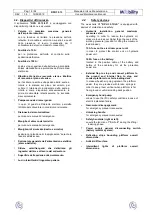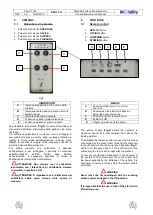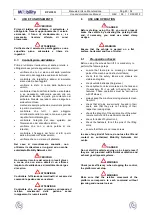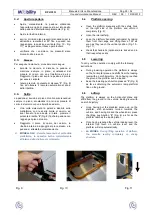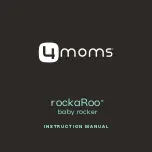
Pag. 16 / 52
RPH 35.13
Manuale di Uso e Manutenzione
REV
05
19/03/2019
Use and Maintenance Manual
PERICOLO
Non tentare di localizzare perdite di olio con le
mani o altre parti del corpo: una perdita, anche
molto piccola, può bucare la pelle provocando
dolorose ferite e infezioni che richiedono
intervento medico tempestivo.
DURANTE IL FUNZIONAMENTO
I
• verificare che il raggio di azione del sollevatore sia
sempre libero da ostacoli;
• non sostare e non lasciar sostare persone nel
raggio di azione del sollevatore;
• l’operatore che manovra il sollevatore deve
mantenersi sempre a distanza di sicurezza e in una
posizione che gli consenta di aver sotto controllo
tutto il raggio d’azione del sollevatore;
• tutte le manovre vanno eseguite con la massima
cautela, tenendo testa, arti e corpo distanti da zone
di cesoiamento, schiacciamento, intrappolamento e
urto;
• controllare che, durante i movimenti, la pedana non
interferisca con alcuna parte del veicolo; assicurarsi,
inoltre, che i cavi di collegamento della pulsantiera
di comando non si impiglino a spigoli del veicolo e/o
organi del sollevatore;
• durante il funzionamento del sollevatore non
appoggiare oggetti sulla pulsantiera e sugli altri
comandi;
• è vietato inserire oggetti fra gli organi in movimento
del sollevatore;
• è vietato lanciare oggetti da e verso il sollevatore;
• non salire e scendere dalla pedana di carico del
sollevatore quando essa è in movimento;
• la sedia a rotelle deve essere obbligatoriamente
frenata
prima
di
iniziare
la
manovra
di
salita/discesa;
•
non movimentare il sollevatore con sequenze
operative di comando in contrasto con quelle
riportate nel
Cap
.6 del presente manuale.
PERICOLO
Non avviare il motore del veicolo in locali chiusi,
a meno che non siano dotati di un efficace
impianto di ventilazione e di smaltimento dei gas
di scarico.
ATTENZIONE
Il sollevatore è stato progettato esclusivamente
per il sollevamento e l’abbassamento di persone
disabili su sedie a rotelle e di un solo operatore
preposto sul/dal pianale dell’autoveicolo al
q
uale è fissato; è pertanto vietato l’uso del
sollevatore per il carico/scarico di altre persone
e/o oggetti.
PERICOLO
L’operatore è tenuto a fermare il sollevatore
qualora le persone presenti nel raggio di azione
della stessa, nonostante i suoi inviti, non si
allontanino.
DANGER
Do not try to locate the oil leaks with your hands
or other body parts: a leakage, even if very
small, can pierce the skin causing painful sores
and infections that require prompt medical
intervention.
DURING THE OPERATION
I
• verify that the radius of action of the lift is always
free of obstructions;
• do not stop and do not let people stop in the radius
of action of the lift;
• the operator who operates the lift must always keep
a safe distance and stay in a position that allows
him to have control over the entire radius of action
of the lift;
• all the manoeuvres should be done with maximum
caution, keeping the head, body and limbs away
from the areas of shearing, crushing, entrapping
and impact;
• check that, during the movements, the platform
does not interfere with any part of the vehicle, also
make sure that the connecting cables of the wired
remote control do not get caught in the corners of
the vehicle and / or parts of the lift;
• when operating the lift do not place any objects on
the push button panel and other commands;
• it is forbidden to insert objects between the moving
parts of the lift;
• it is forbidden to throw objects to and from the lift;
• do not lift or to low from the loading platform of the
lift when it is moving;
• the brakes should be compulsorily applied to the
wheelchair before starting the manoeuvre of lifting /
lowering;
• do not move the lift in operational sequences of
command in contrast with those shown in
Chapter
of this manual;
DANGER
Do not start the vehicle engine in enclosed areas,
unless they are equipped with an effective
ventilation system and a system for disposal of
exhaust gases.
WARNING
The lift has been designed exclusively for lifting
and lowering disabled persons in wheelchairs with
a single operator in charge to / from the floor of the
car to which it is fixed; the use of the lift for loading
/unloading other persons and/or objects is
therefore forbidden.
DANGER
The operator is required to stop the machine if the
people in the radius of action of the same, do not
go away despite his requests.

















